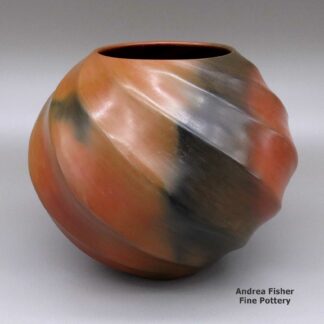Manymules, Samuel

“I spend most of my days envisioning the shapes, planning how to make a vision a reality, and imagining how the completed pot will look.”
Samuel Manymules was born into the Bitterwater Clan of the Red Horse Nakai Navajo Clan in August, 1963. For many years he says he only did what he needed to to get by. Jobs that still stick out in his mind are jewelry making, driving a tow truck and working at an auto dealership trying to make ends meet.
Then he started finding potsherds on the ground in the area around where he lived. They intrigued him enough that he taught himself how to make pottery the traditional way.
He says he got his inspiration in the early days by looking at the pottery of Christine McHorse and Joseph Lonewolf.
After ten years of dabbling with clay, he perfected a thin wall version of Navajo pottery and with his typical high fire practice, he’s since elevated Navajo pottery to a whole new level.
Samuel tells us he builds his pots in his mind before he ever puts his hands in the clay. “I spend most of my days envisioning the shapes, planning how to make a vision a reality, and imagining how the completed pot will look,” he told us.
In keeping with Navajo tradition, Samuel neither paints nor carves his pieces. He knows his clay so well he pushes and presses it into the forms he wants, creating the architectural angles of a master and decorating without actually decorating. Then he leaves the making of color variations to the firing process where he says the Hand of the Creator makes its mark.
Samuel has a long list of accomplishments and awards in the pottery world. The basics of the list cover most of a printed page as he has won many prominent awards from some of the most distinguished juried competitions in the southwestern United States.
Some Awards Samuel has earned
- 2019 Santa Fe Indian Market: Classification II – Pottery, Division A – Traditional Unpainted Pottery, Category 501 – Pitch Finish, any form: Second Place
- 2018 Santa Fe Indian Market: Classification II – Pottery, Division A – Traditional Unpainted Pottery, Category 501 – Pitch Finish, any form: First Place
- 2018 Heard Museum Guild Indian Fair & Market, Classification II – Pottery, Division B – Unpainted, including ribbed, native clay, hand built, fired out-of-doors: Second Place. Awarded for a Four-Sided Swirled Water Jar
- 2017 Santa Fe Indian Market: Classification II – Pottery, Division A – Traditional Unpainted Pottery, Category 501 – Pitch Finish, any form: First Place
- 2017 Santa Fe Indian Market: Classification II – Pottery, Division A – Traditional Unpainted Pottery, Category 504 – Melon bowls and melon jars, formed or carved: Second Place
- 2017 Heard Museum Guild Indian Fair & Market, Classification II – Pottery, Division B – Unpainted, Including Ribbed Native Clay, Hand Built, Fired Out-of-Doors: Second Place. Awarded for Artwork: “Kiva Entry”
- 2015 Heard Museum Guild Indian Fair & Market, Classification II – Pottery, Division E – Non-traditional design or form with native materials: First Place
- 2014 Heard Museum Guild Indian Fair & Market, Classification II – Pottery, Division B – Traditional, native clay, hand built, unpainted including ribbed: Second Place. Awarded for Melon Swirl Water Jar
- 2013 Heard Museum Guild Indian Fair & Market, Classification II – Pottery, Division B – Traditional, native clay, hand built, painted, including ribbed: First Place
- 2012 Heard Museum Guild Indian Fair & Market, Classification II – Pottery, Division B – Traditional, native clay, hand built, unpainted including ribbed: First Place
- 2012 Heard Museum Guild Indian Fair & Market: Judge’s Award – Martha Streuver. Awarded for artwork: Water Jar
- 2011 Heard Museum Guild Indian Fair & Market, Classification II – Pottery, Division B – Traditional, native clay, hand built, unpainted including ribbed: First Place
- 2010 Heard Museum Guild Indian Fair & Market, Classification II – Pottery, Division C – Traditional, native Clay, hand built, carved: Second Place
- 2010 Heard Museum Guild Indian Fair & Market, Classification II – Pottery, Division B – Traditional, native clay, hand built, unpainted including ribbed: First Place
- 2009 Heard Museum Guild Indian Fair & Market, Classification II – Pottery, Division B – Traditional, native clay, hand-built, unpainted: First Place
- 2008 Heard Museum Guild Indian Fair & Market, Classification II – Pottery, Division E – Non-traditional design or form with Native materials: Second Place
- 2008 Heard Museum Guild Indian Fair & Market: Judge’s Choice Award – Marcus Monenerkit
- 2007 Heard Museum Guild Indian Fair & Market, Classification II – Pottery, Division B – Traditional, native clay, hand-built, unpainted: Second Place
- 2006 Heard Museum Guild Indian Fair & Market, Classification II – Pottery, Division C – Traditional – Native clay/hand built/carved/ribbed/incised: First Place
- 2005 Heard Museum Guild Indian Fair & Market, Classification II – Pottery Division B – Traditional/native clay/hand-built (unpainted): Honorable Mention
- 2004 Santa Fe Indian Market, Classification II – Pottery, Division A – Traditional unpainted pottery, Category 801 – Navajo style all forms: Second Place
- 2004 Santa Fe Indian Market, Classification II – Pottery, Division A – Traditional unpainted pottery, Category 801 – Navajo style all forms: Third Place
- 2004 Santa Fe Indian Market, Classification II – Pottery, Division B – Traditional undecorated, Category 901: Third Place
- 2004 Heard Museum Guild Indian Fair & Market, Classification II – Pottery: Best of Classification
- 2004 Heard Museum Guild Indian Fair & Market, Classification II – Pottery, Division B – Traditional/native clay/hand-built (unpainted): Best of Division
- 2003 Heard Museum Guild Indian Fair & Market, Classification II – Pottery, Division B – Traditional/native clay/hand-built (unpainted): Honorable Mention
Showing the single result
Showing the single result
